Parkhurst's Stitchdown Allen Boots in Horween's Brown Waxed Flesh
Dec 17, 2024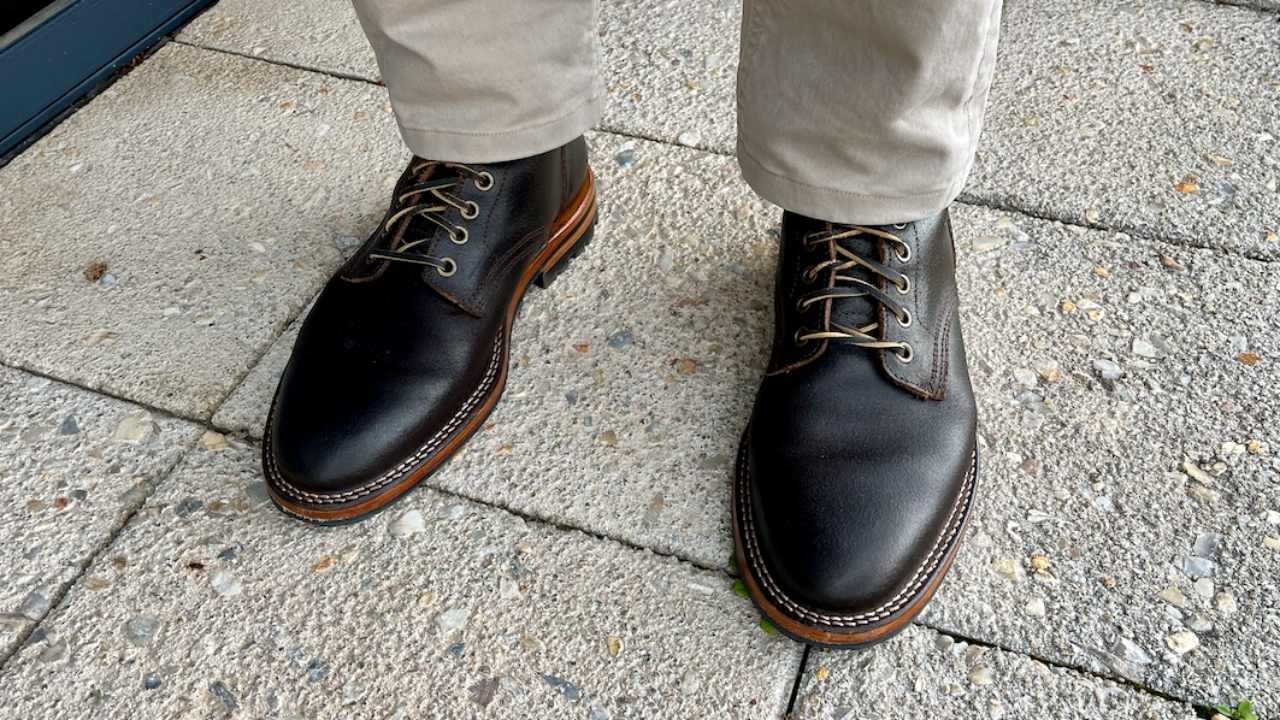
It’s no secret, I’m a huge fan of Parkhurst boots.
In this almond toe last, combined with Horween’s famous waxed flesh, it’s a perfect blend of style and ruggedness that I can only describe, in all my enthusiasm, as an unpolished diamond.
The Allen is Parkhurst’s plain-toe service boot. This version is a stitchdown boot, which I’ll explain when I go into the construction. Aesthetically, it has all the badges of a service boot - Derby open lacing system, low block heel, six inches high at the shaft, and reasonably plain leather pieces made up of the vamp, two quarters, and a single piece backstay that cups the external heel counter.
Made from Horween’s waxed flesh, this one in a dark brown, expect it to be a patina monster - but only after a heck of a lot of wear, which I’ll explain in a minute.
For now, you can watch my review by clicking on the image below, or read on and then come back to watch the video.
As a result of all that expected patina, expect it to be a casual pair of boots that you pair with very casual outfits, rather than smart casual with wool pants. Pairing it with denim jeans is probably the best bet, particularly dark selvedge denim because as the selvedge denim fades, so the waxed flesh will patina and keep the match going.
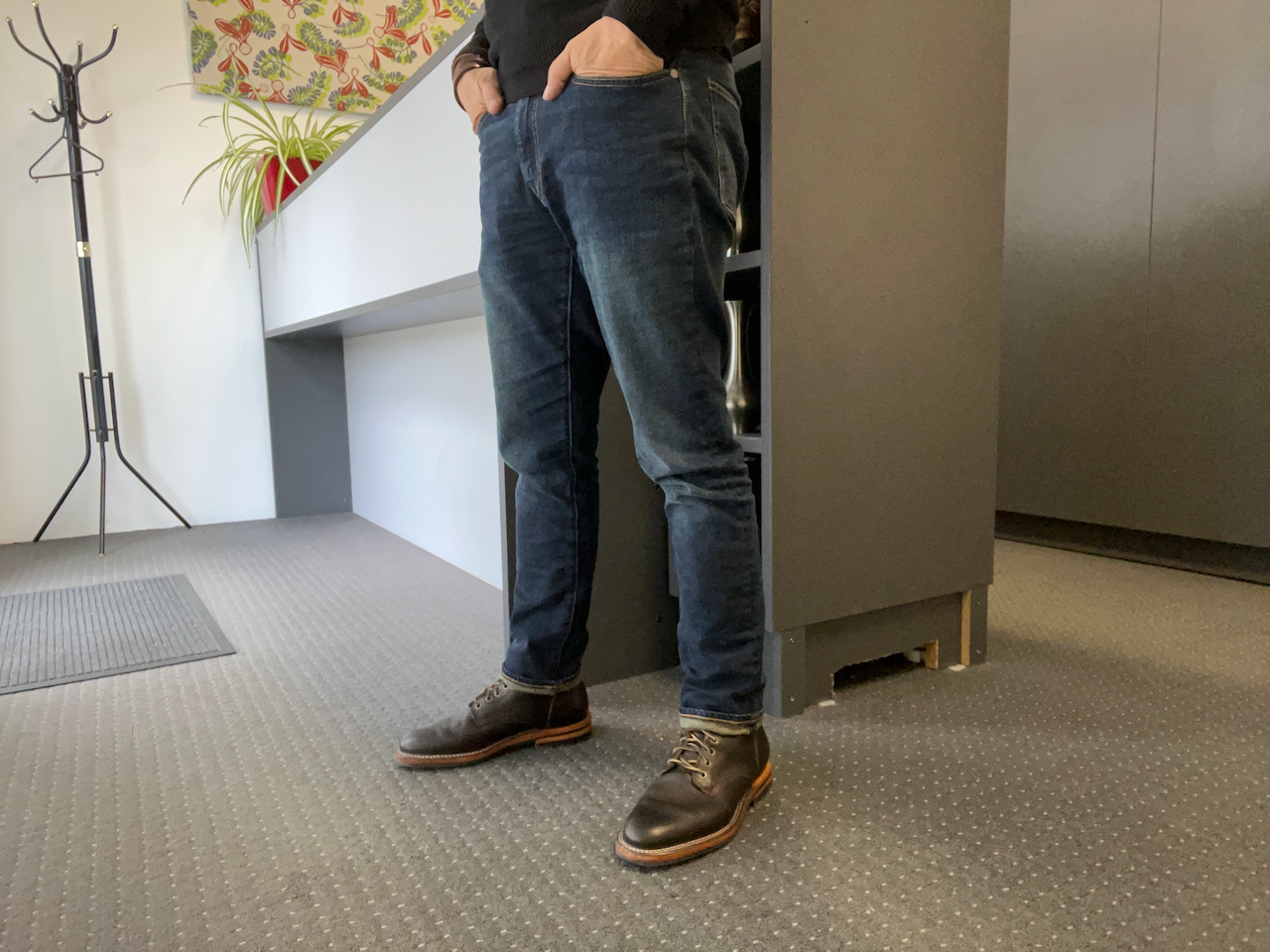
Parkhurst was founded in 2018 by Andrew Svisco, a former stock analyst, as a small-batch manufacturer of American-style heritage boots. As a small batch manufacturer, Parkhurst’s business model was to buy limited stocks of hides, in traditional and exotic leathers, from Horween’s smooth grain leathers to Charles Stead’s waxed and shrunken suedes, taking in along the way, leathers like Moose, Kudu and horse butt.
The design philosophy was to combine a well-fitting last in a slimmed-down service boot design, with interesting, exotic and rugged leathers, and build them on a variety of outsoles from studded Dainite to comfortable Ridgeway and the commando lugged styles. Andrew also started with the desire to keep his supply chains local, contracting a boot factory in Upstate New York, as well as sourcing materials from local suppliers, even if that meant buying say, UK tannery Stead’s leathers through a US supplier rather than buying direct.
Unfortunately, COVID nearly destroyed his business, and did devastate his US supply chains with many of his suppliers, including the Batavia factory, closing down for good. However, his contacts put him in touch with a Spanish factory, and after two lean years where the Parkhurst website went down to no more than 3 or 4 models available at a time, Andrew survived on the smell of an oily rag and pulled through.
As more and more models came out of the Spanish factory, 2024 culminated in a true rebirth for Parkhurst, with many models appearing in stock, and in 2024, Andrew also explored stitchdown construction with a Portuguese factory that had the skills and capacity to produce stitchdown boots.
His website today, shows various models of plain and captoe service boots, moc toes, and even chukkas and oxfords. Where once you may have complained that his choices were few, they now are a-plenty, but be quick, because he remains a small batch manufacturer and styles sell out fast and are not replaced, or replaced by different styles, or subject to a wait when he eventually re-stocks.
Turning to construction now, this is put together using the stitchdown method of construction.
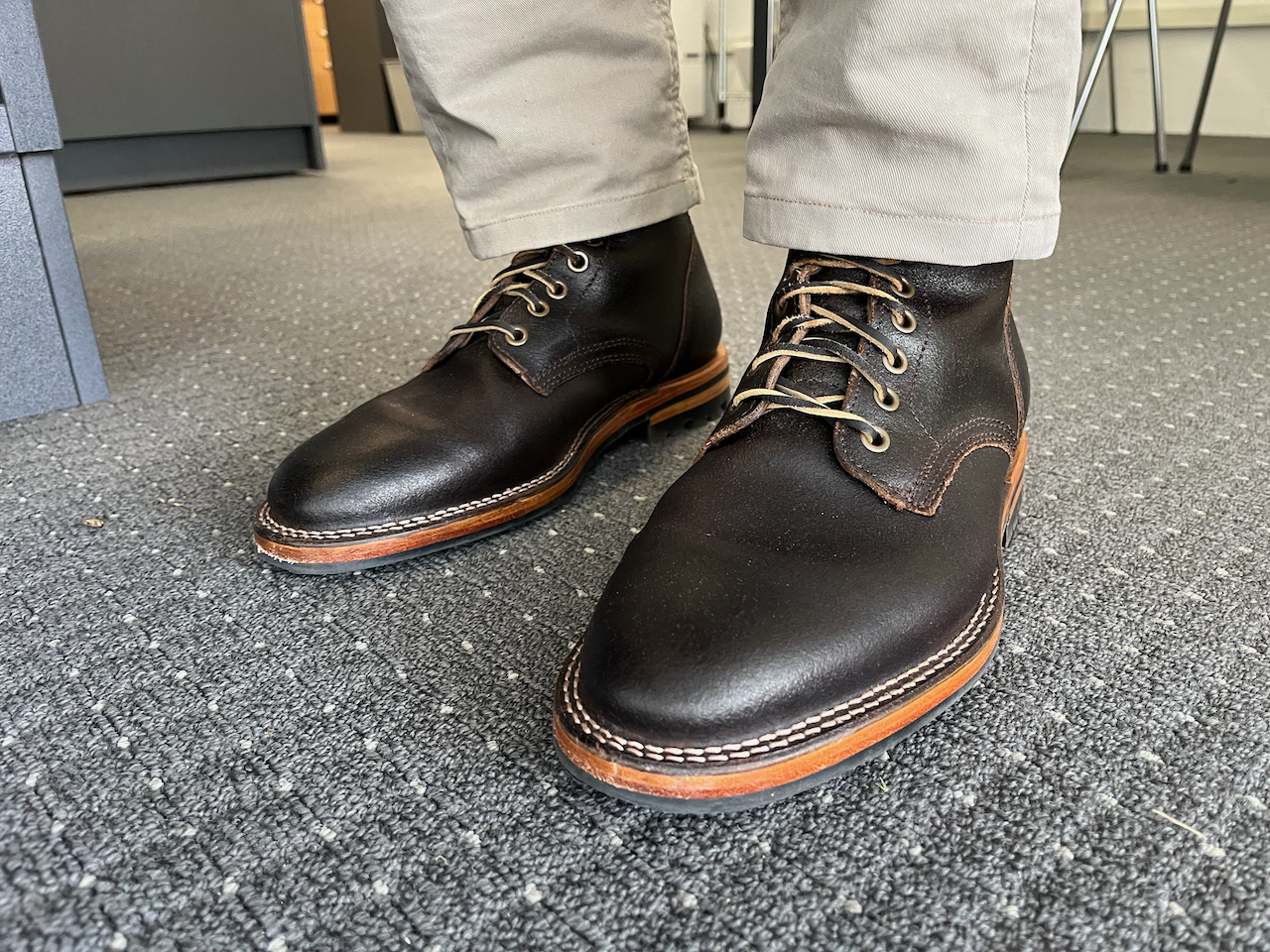
The uppers leather is lasted over the last, to form the shape of the uppers, and then the edges are flared out and glued to the midsole (there's no welt), before being stitched through the midsole to the outsole. In this case, it’s a double stitch stitchdown, meaning two stitches go through the top of the flared-out uppers and midsole, but only one stitch goes through all the way, through to the outsole. The back end is then tucked in and glued and stitched to the insole, and also affixed with nails.
This form of construction allows for a sturdy, lasting build, as well as water resistance because the water is said to roll off the vamp and the turned-out uppers. Goodyear welt enthusiasts would probably beg to differ and I’m not really 100% sure which is more water resistant.
The outsole itself is a Parkhurst-branded proprietary commando lugged sole. It’s a full slip outsole that goes the whole length of the boot, and at the heel, is topped by a glued and nailed leather heel stack, finished, usually by Andrew himself in his Buffalo warehouse, with a commando lugged top lift.

The interesting thing I’ve found is that the Portuguese commando outsoles seem to have a lower profile than the Spanish ones - I don’t know if they are different manufacturers or just specs.
The rubber is softer than Vibram's V100 commando outsoles, or even their 430 mini-lug soles, and I have to say, feels more comfortable. The midsole is a double layer of veg-tanned bends leather and truthfully, does need a bit of wear to break in to get it to bend comfortably.
Inside the boot, the insole is also veg tanned bends leather so is very firm and supportive, and with a cork filler layer underneath, I really can feel the impression of my feet snuggle into it and form it’s own orthotic support.
There is a steel shank that bridges the gap under the arch and prevents the gap at the arch from collapsing, as well as torsional stability over uneven ground.
The uppers are made from Horween’s waxed flesh. Let’s break that down a bit.
Firstly, Horween is a renowned tannery from Chicago in the US, and it produces the ubiquitous Chromexcel leather tannage. Interestingly, this is actually Chromexcel turned inside out - you can see the natural Chromexcel smoothness and natural colour on the inside.
Waxed flesh is a form of leather that is turned rough side out, and then the roughout nap is covered with a thick coat of wax that more than makes it waxy like on Charles F Stead’s waxy commander waxed suede. Whereas Waxy Commander is designed to crack and show the suede nap very quickly, revealing the tanned colour under a darker wax, Waxed Flesh on the other hand is designed as a hardy, heavily waxed roughout that can, and is used for work boots. The much thicker wax layer on the surface takes much more of a beating before it reveals the inside colour of the throughout nap.
The inside of the vamp is lined with a soft lining leather, but the shaft is unlined. Not that it really needs lining because what is usually the smooth grain surface is turned inside-out and the smooth side is put against your leg.
I have a pair of White’s MP boots in Cinnamon Waxed Flesh, which I HAVE worn in my garage workshop and on the hiking trail, and that does show a lot of patina. You can check out that video, here.
You can see on the vamp that even with the couple of handfuls of wear that the rolls are forming but without any creasing. Until the wax wears off the vamp will crack rather than crease, and then the roughout nap showing will prevent any really bad creasing anyway.
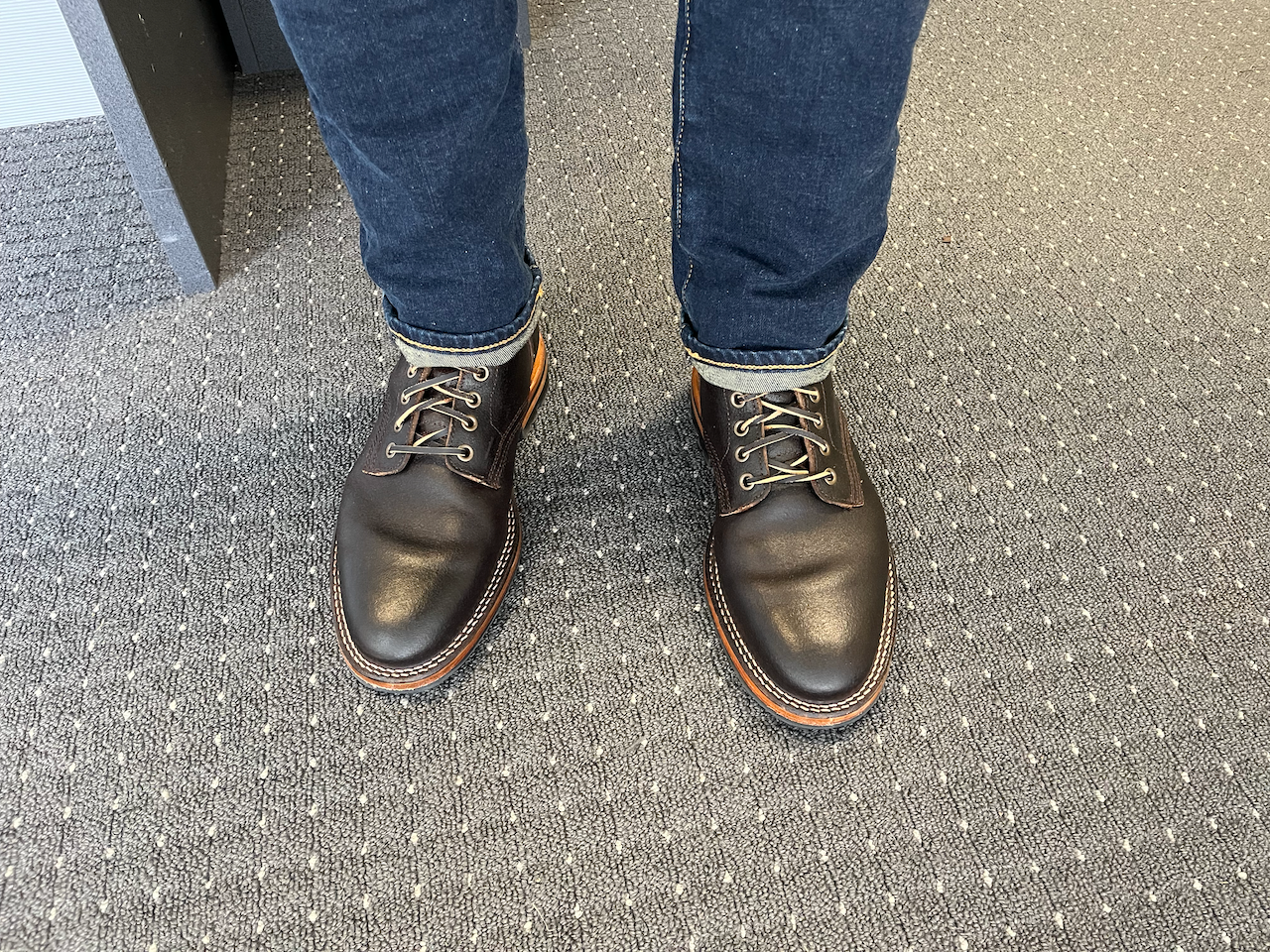
I find the texture, especially on the shaft where it’s become a little more supple, very appealing in its roughness, even before the wax cracks or scuffs.
The stitching on the uppers is first class - very clean and consistent and not loose or missed stitching. It’s quadruple and double-stitched where it’s needed. The stitching on the stitchdown is also clean and consistent - I believe machine rather than hand stitched, but still, you need a steady and practised hand guiding the boot through the machine.
The stitch per inch or SPI density is not particularly fine like a Viberg say, but people say that a really dense SPI might be really tricky to re-sole because your cobbler has to match his stitches into the very fine old holes, otherwise stitching too many new holes into the uppers may turn it into a perforated edge like toilet paper.
The edges of the leather are cut edges as befits a rugged boot, and the hardware is equally tough antiqued brass, five eyelets and three speed hooks, all backed really well with no rough edges to feel.
The tongue is partially gusseted up to the last eyelet, to provide a little more protection from moisture and dirt.
All in all, well thought through and well executed.
LEATHERCARE
As for caring for waxed flesh, it’s a pretty tough coating but nevertheless, you do want to protect it from drying out, especially once the wax cracks and the roughout nap starts to show. Parkhurst’s website recommends Smith's, Bick4, or any neutral color creme, wax or balm, to condition the leather. Truman Boots, who are famous for their Java Waxed Flesh boot, suggest their proprietary Leather Protector, which I understand is a waxy balm like Smith’s.
In my personal opinion, I’d leave waxed flesh alone as far as I can do so.
Keep it clean by wiping it down with a damp cloth and then brush it if it gets dirty. As the nap starts to show, I’d spray on a suede protector like the ones you can get from Red Wing or R M Williams, or a waterproof spray like the Tarrago Nanospray. If it really feels dry, I’d probably apply Bick 4 more than a waxy balm because I think a waxier cream or balm is likely to darken the roughout showing, and if you like the patina that’s developing, Bick 4 will condition but not cover it with a replacement waxy surface.
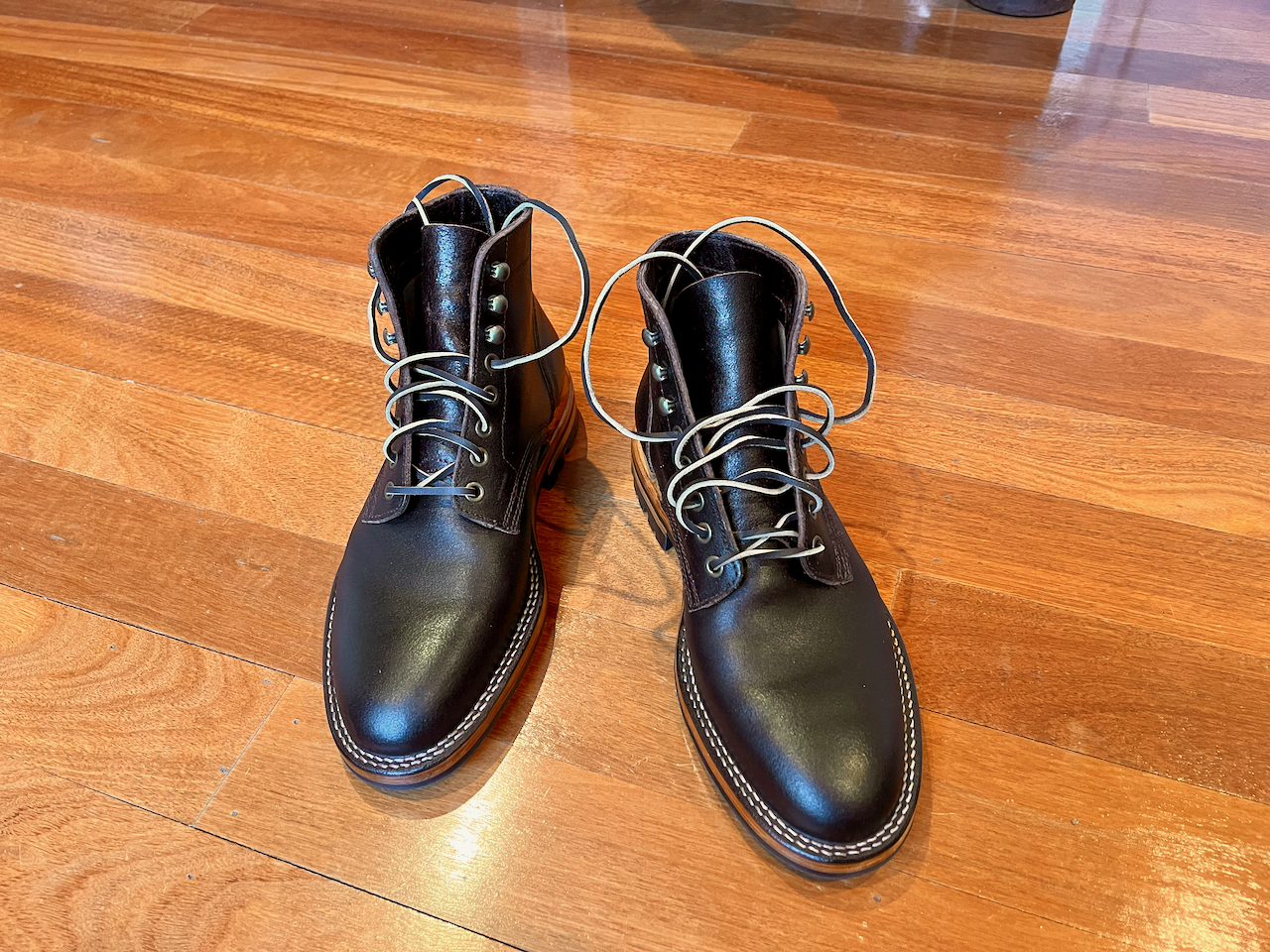
SIZING, FIT AND COMFORT
As to sizing, fit and comfort, this is made on Parkhurst’s 618 last, which is a combination last with a narrow heel and waist and opening to just above E width at the ball, before coming back into an almond-shaped toe. The 618 last is designed to look sleek without squeezing your toes, but does clamp your heel in place and provides arch support through the narrow waist.
For most people, you would take a half size down from your Brannock device size, and maybe up to a full size down from your sneaker size. In my own example, I size 8 ½ D in US sizing, and I wear a 9 in Nike’s. In Red Wing, Allen Edmonds, Grant Stone and almost all other US heritage brands, I take an 8 D. For UK sizing countries like the UK, Australia, Canada and South Africa, that’s a 7 ½ true size since most Commonwealth country manufacturers make footwear true to size.
With all that information, I order a size 8 in Parkhurst.
However, if your feet are especially wide or you have splayed toes to something, contact Andrew because I have heard people say that their feet just don’t work in Parkhurst’s combination lasts.
As for fit, the 618 last is perfect for my average but imperfect feet.
The narrow heel locks in my heel to reduce heel slip, even when new. The narrow waist grips my mid-foot, and the design tucks the uppers in under your arch so that you feel an extra structural arch support. The width at the ball of the feet provides a lot of comfort, despite the sleek profile, and the slightly extra length allows the toes to narrow in without forcing your toes into a tight toe box.
The boots are shock-absorbing enough, even though the commando lugs can jar on a concrete pavement, but they are also comfortable whether standing or walking.
VALUE
At the time of writing, the boots sell for US$ 438.
It’s hard to compare value in Australia because we just don’t make boots like these. I don’t think you can compare handmade boots like Woottens because that’s a whole different category, and the closest is R M Williams which mostly sell for the mid to high six hundreds in Australian Dollars.
In the US though, where these will have the biggest market, they compare well with other brands of similar quality. Grant Stone boots sell for under US$ 400 and while incredibly well-made from the highest quality materials, have the advantage of being made in China with the relatively low cost of production. Truman sell their Java Waxed Flesh for US$ 48, and they are comparable in build and quality, but with US wage rates factored in. I don’t think you can rightly compare these with Pacific North West boots but they are more consistent in quality even if factory-made rather than PNW hand-made at PNW prices.
I think overall, their price-to-value ratio is fair to pretty good. And in summary, I think that’s my fairest call, given that Parkhurst is probably my favourite brand.
I like the look, I like the philosophy of the maker, and I like the more recent consistency in quality from the Spanish and Portuguese factories.

Stay connected with news and updates!
Join our mailing list to receive the latest news and updates from Bootlosophy.
Don't worry, your information will not be shared.
We hate SPAM. We will never sell your information, for any reason.

